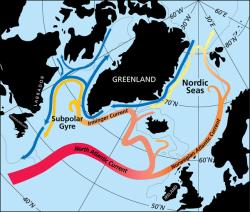February 16, 2010
Source: Media Relations
Waters from warmer latitudes — or subtropical waters — are reaching Greenland's glaciers, driving melting and likely triggering an acceleration of ice loss, reports a team of researchers led by Fiamma Straneo, a physical oceanographer from the Woods Hole Oceanographic Institution (WHOI).
"This is the first time we’ve seen waters this warm in any of the fjords in Greenland ," says Straneo. "The subtropical waters are flowing through the fjord very quickly, so they can transport heat and drive melting at the end of the glacier."
Greenland's ice sheet, which is two-miles thick and covers an area about the size of Mexico, has lost mass at an accelerated rate over the last decade. The ice sheet's contribution to sea level rise during that time frame doubled due to increased melting and, to a greater extent, the widespread acceleration of outlet glaciers around Greenland.
While melting due to warming air temperatures is a known event, scientists are just beginning to learn more about the ocean's impact — in particular, the influence of currents — on the ice sheet.
"Among the mechanisms that we suspected might be triggering this acceleration are recent changes in ocean circulation in the North Atlantic, which are delivering larger amounts of subtropical waters to the high latitudes," says Straneo. But a lack of observations and measurements from Greenland's glaciers prior to the acceleration made it difficult to confirm.
The research team, which included colleagues from University of Maine, conducted two extensive surveys during July and September of 2008, collecting both ship-based and moored oceanographic data from Sermilik Fjord — a large glacial fjord in East Greenland.
Sermilik Fjord, which is 100 kilometers (approximately 62 miles) long, connects Helheim Glacier with the Irminger Sea. In 2003 alone, Helheim Glacier retreated several kilometers and almost doubled its flow speed.
Deep inside the Sermilik Fjord, researchers found subtropical water as warm as 39 degrees Fahrenheit (4 degrees Celsius). The team also reconstructed seasonal temperatures on the shelf using data collected by 19 hooded seals tagged with satellite-linked temperature depth-recorders. The data revealed that the shelf waters warm from July to December, and that subtropical waters are present on the shelf year round.
"This is the first extensive survey of one of these fjords that shows us how these warm waters circulate and how vigorous the circulation is," says Straneo. "Changes in the large-scale ocean circulation of the North Atlantic are propagating to the glaciers very quickly — not in a matter of years, but a matter of months. It's a very rapid communication."
Straneo adds that the study highlights how little is known about ocean-glacier interactions, which is a connection not currently included in climate models.
"We need more continuous observations to fully understand how they work, and to be able to better predict sea-level rise in the future," says Straneo.
The paper was chosen for advanced online publication Feb. 14, 2010, by Nature Geosciences; it will also appear in the March 2010 printed edition of the journal. Co-authors of the work include WHOI postdoc David Sutherland (now of University of Washington), Gordon Hamilton and Leigh Stearns of the Climate Change Institute, University of Maine, Fraser Davidson and Garry Stenson of the Department of Fisheries and Oceans, St. John’s, Newfoundland, Mike Hammill of the Department of Fisheries and Oceans, Mont-Joli, Quebec, and Aqqalu Rosing-Asvid of the Department of Birds and Mammals, Greenland Institute of Natural Resources. Canadian and Greenlandic colleagues contributed valuable data on the shelf, from tagged seals.
Funding for this research was provided by the National Science Foundation, WHOI's Ocean and Climate Change Institute Arctic Research Initiative, and NASA’s Cryosperic Sciences Program.
#
The Woods Hole Oceanographic Institution is a private, independent organization in Falmouth, Mass., dedicated to marine research, engineering, and higher education. Established in 1930 on a recommendation from the National Academy of Sciences, its primary mission is to understand the oceans and their interaction with the Earth as a whole, and to communicate a basic understanding of the oceans' role in the changing global environment.
